NCERT Solutions for Class 12 Maths Chapter 8 Application of integrals
Imagine you have a curved shape, like the edge of a hill or a wave, and you want to find out how much space it occupies between the curve and the ground (x-axis). That space under the curve is called the area, and we calculate it using integration. Integrals are the functions that satisfy a given differential equation for finding the area of a curvy region y = f (x), the x-axis, and the lines x = a and x = b (b>a). Therefore, finding the integral of a function with respect to x means finding the area above the x-axis from the curve. The integral is also called an antiderivative, as it is the reverse process of differentiation. The main objective of these NCERT Solutions for class 12, the application of integrals, is to provide students with a clear understanding of how integration is used to calculate areas bounded by curves and to strengthen their problem-solving skills in real-life applications.
This Story also Contains
- Application Of Integrals Class 12 Maths Chapter 8: Free PDF Download
- NCERT Application Of Integrals Class 12 Questions And Answers (Exercise)
- Application of Integrals Class 12 NCERT Solutions: Exercise-wise
- Application Of Integrals Class 12 Chapter 8: Topics
- Application Of Integrals Class 12 NCERT Solutions - Important Formulae
- What Extra Should Students Study Beyond the NCERT for JEE?
- Why are Class 12 Maths Chapter 8 Application of Integrals question answers important?
- NCERT solutions for class 12 maths - Chapter-wise
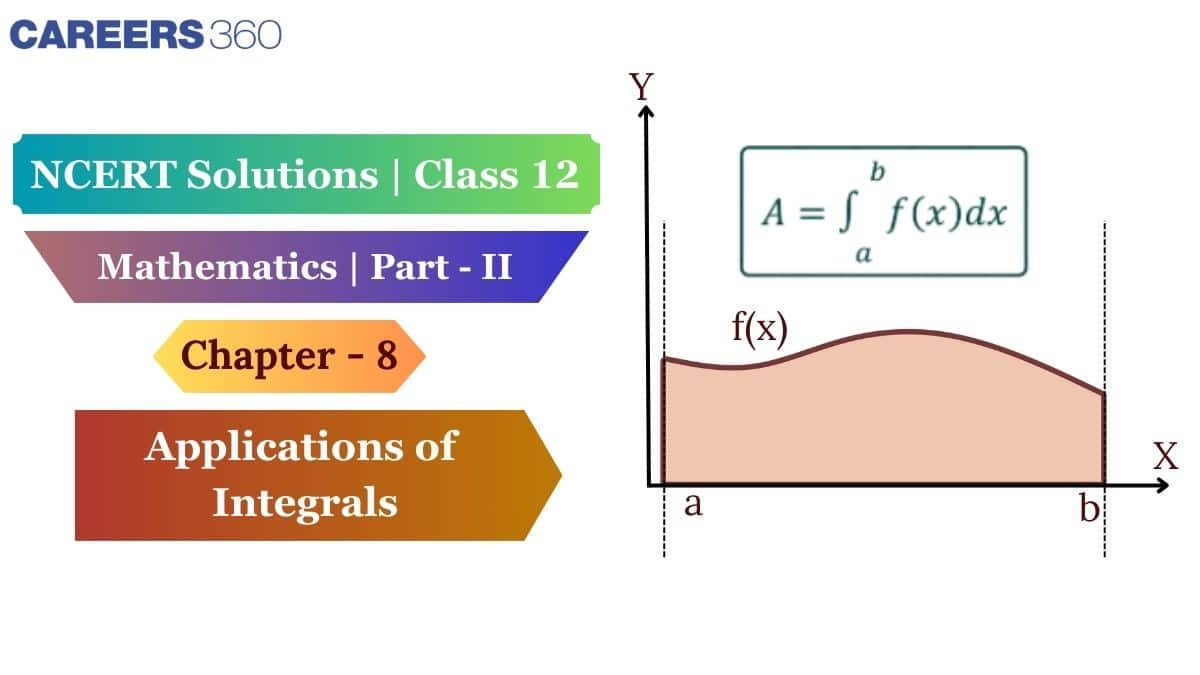
Integration teaches us how small changes add up to make a measurable difference. These NCERT Solutions for Class 12 are trustworthy and reliable, as they are created by subject matter experts at Careers360, making them an essential resource for exam preparation. NCERT Solutions are trusted by teachers for building a strong foundation in concepts. Students can additionally refer to the NCERT exemplar and notes for better practice and understanding of the topic. Find everything in one place – NCERT Books, Solutions, Syllabus, and Exemplar Problems with Solutions – in this NCERT article.
Application Of Integrals Class 12 Maths Chapter 8: Free PDF Download
The NCERT Solutions for Class 12 Maths Chapter 8 have been prepared by Careers360 experts to make learning simpler and to help you score better in exams. A downloadable PDF is available — click the link below to access it.
NCERT Application Of Integrals Class 12 Questions And Answers (Exercise)
NCERT Class 12 Maths Chapter 6 Application of Integrals question answers with detailed explanations are provided below.
|
Application of Integrals Class 12 Question Answers Exercise: 8.1 Page number: 296 Total questions: 4 |
Question 1: Find the area of the region bounded by the ellipse $\frac{x^2}{16}+\frac{y^2}{9}=1.$
Answer:
The area bounded by the ellipse : $\frac{x^2}{16}+\frac{y^2}{9}=1$

The area will be 4 times the area of EAB.
Therefore, $Area\ of\ EAB= \int^4_{0} y dx$
$= \int^4_{0}3\sqrt{1-\frac{x^2}{16}} dx$
$= \frac{3}{4}\int^4_{0}\sqrt{16-x^2} dx$
$= \frac{3}{4}\left [ \frac{x}{2}\sqrt{16-x^2}+\frac{16}{2}\sin^{-1}\frac{x}{4} \right ]^4_{0}$
$= \frac{3}{4}\left [ 2\sqrt{16-16} +8\sin^{-1}(1)-0-8\sin^{-1}(0)\right ]$
$= \frac{3}{4}\left [ \frac{8\pi}{2} \right ]$
$= \frac{3}{4}\left [ 4\pi \right ] =3\pi$
Therefore, the area bounded by the ellipse will be $= 4\times {3\pi} = 12\pi\ units.$
Question 2: Find the area of the region bounded by the ellipse $\small \frac{x^2}{4}+\frac{y^2}{9}=1$
Answer:
The area bounded by the ellipse : $\small \frac{x^2}{4}+\frac{y^2}{9}=1$

The area will be 4 times the area of EAB.
Therefore, $Area\ of\ EAB= \int^2_{0} y dx$
$= \int^2_{0}3\sqrt{1-\frac{x^2}{4}} dx$
$= \frac{3}{2}\int^2_{0}\sqrt{4-x^2} dx$
$= \frac{3}{2}\left [ \frac{x}{2}\sqrt4-x^2 +\frac{4}{2}\sin^{-1}\frac{x}{2} \right ]^2_{0}$
$= \frac{3}{2}\left [ \frac{2\pi}{2} \right ]$
$= \frac{3\pi}{2}$
Therefore, the area bounded by the ellipse will be $= 4\times \frac{3\pi}{2} = 6\pi\ units.$
Question 3: Choose the correct answer in the following
Answer:
The correct answer is A
The area bounded by circle C(0,0,4) and the line x=2 is
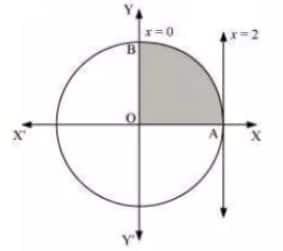
The required area = area of OAB
$\int^2_0ydx = \int^2_0\sqrt{4-x^2}dx$
$\\=[\frac{x}{2}\sqrt{4-x^2}+\frac{4}{2}\sin^{-1}\frac{x}{2}]^2_0\\ =2(\pi/2)\\ =\pi$
Question 4: Choose the correct answer in the following.
(A) $\small 2$ (B) $\small \frac{9}{4}$ (C) $\small \frac{9}{3}$ (D) $\small \frac{9}{2}$
Answer:
The area bounded by the curve $y^2=4x$ and y =3
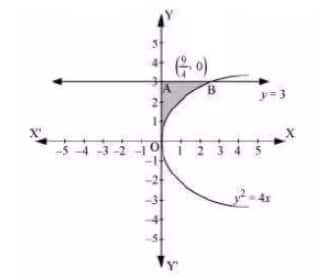
The required area = OAB =
$\\\int ^3_0xdy\\ =\int ^3_0\frac{y^2}{4}dy\\ =\frac{1}{4}.[\frac{y^3}{3}]^3_0\\ =\frac{9}{4}$
|
Application of Integrals Class 12 Question Answers Page Number: 298 Total Questions: 5 |
Question 1: Find the area under the given curves and given lines:
(i) $\small y=x^2,x=1,x=2$ and $\small x$ -axis
Answer:
The area bounded by the curve $\small y=x^2,x=1,x=2$ and $\small x$ -axis
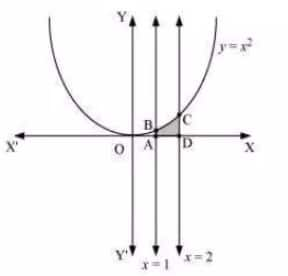
The area of the required region = area of ABCD
$\\=\int_{1}^{2}ydx\\ =\int_{1}^{2}x^2dx\\ =[\frac{x^3}{3}]_1^2\\ =\frac{7}{3}$
Hence, the area of the shaded region is 7/3 units.
Question 1: Find the area under the given curves and given lines:
(ii) $\small y=x^4,x=1,x=5$ and $\small x$ -axis
Answer:
The area bounded by the curev $\small y=x^4,x=1,x=5$ and $\small x$ -axis
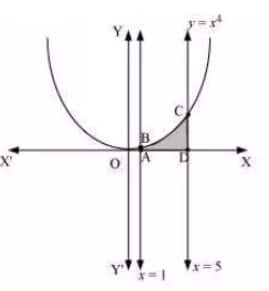
The area of the required region = area of ABCD
$\\=\int_{1}^{5}ydx\\ =\int_{1}^{2}x^4dx\\ =[\frac{x^5}{5}]_1^2\\ =625-\frac{1}{5}\\ =624.8$
Hence, the area of the shaded region is 624.8 units.
Question 2: Sketch the graph of $\small y=|x+3|$ and evaluate $\small \int_{-6}^{0}|x+3|dx.$
Answer:
y=|x+3|
The given modulus function can be written as
x+3>0
x>-3
for x>-3
y=|x+3|=x+3
x+3<0
x<-3
For x<-3
y=|x+3|=-(x+3)
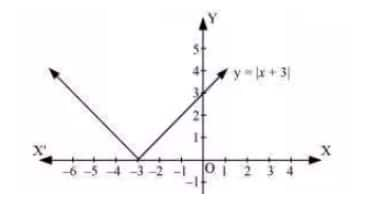
The integral to be evaluated is
$\\\int_{-6}^{0}|x+3|dx$
$=\int_{-6}^{-3}(-x-3)dx+\int_{-3}^{0}(x+3)dx$
$ =[-\frac{x^{2}}{2}-3x]_{-6}^{-3}+[\frac{x^{2}}{2}+3x]_{-3}^{0}$
$=(-\frac{9}{2}+9)-(-18+18)+0-(\frac{9}{2}-9)\\ =9$
Question 3: Find the area bounded by the curve $\small y=\sin x$ between $\small x=0$ and $\small x=2\pi$.
Answer:
The graph of y=sinx is as follows
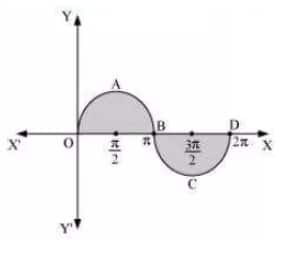
We need to find the area of the shaded region.
ar(OAB)+ar(BCD)
=2ar(OAB)
$\\=2\times \int_{0}^{\pi }sinxdx\\ =2\times [-cosx]_{0}^{\pi }\\ =2\times [-(-1)-(-1)]\\ =4$
The bounded area is 4 units.
Question 4: Choose the correct answer.
(A) $\small -9$ (B) $\small \frac{-15}{4}$ (C) $\small \frac{15}{4}$ (D) $\small \frac{17}{4}$
Answer:

Hence, the required area
$=\int_{-2}^1 ydx$
$=\int_{-2}^1 x^3dx = \left [ \frac{x^4}{4} \right ]_{-2}^1$
$= \left [ \frac{x^4}{4} \right ]^0_{-2} + \left [ \frac{x^4}{4} \right ]^1_{0}$
$= \left [ 0-\frac{(-2)^4}{4} \right ] + \left [ \frac{1}{4} - 0 \right ]$
$= -4+\frac{1}{4} = \frac{-15}{4}$
Therefore, the correct answer is B.
Question 5: Choose the correct answer.
(A) $\small 0$ (B) $\small \frac{1}{3}$ (C) $\small \frac{2}{3}$ (D) $\small \frac{4}{3}$
[ Hint : $y=x^2$ if $x> 0$ and $y=-x^2$ if $x<0$ . ]
Answer:
The required area is
$\\2\int_{0}^{1}x^{2}dx\\ =2\left [ \frac{x^{3}}{3} \right ]_{0}^{1}\\ =\frac{2}{3}\ units$
Application of Integrals Class 12 NCERT Solutions: Exercise-wise
Exercise-wise NCERT Solutions of Application of Integrals Class 12 Maths Chapter 8 are provided in the links below.
Application Of Integrals Class 12 Chapter 8: Topics
Topics you will learn in NCERT Class 12 Maths Chapter 8 Application of Integrals include:
- 8.1 Introduction
- 8.2 Area under Simpler Curves
Application Of Integrals Class 12 NCERT Solutions - Important Formulae
1. Area Enclosed by a Curve and Lines:
The area enclosed by the curve $y=f(x)$, the $x$-axis, and the lines $x=a$ and $x=b$ (where $b>a$ ) is given by the formula:
Area $=\int_a^b y d x=\int_a^b f(x) d x$
2. Area Bounded by Curve and Horizontal Lines:
The area of the region bounded by the curve $x=\phi(y)$ as its $y$-axis and the lines $y=c$ and $y=d$ is given by the formula:
Area $=\int_c^d x d y=\int_c^d \phi(y) d y$
3. Area Between Two Curves and Vertical Lines:
The area enclosed between two given curves $y=f(x)$ and $y=g(x)$, and the lines $x=a$ and $x=b$, is given by the formula:
Area $=\int_a^b[f(x)-g(x)] d x \quad($ Where $f(x) \geq g(x)$ in $[a, b])$
4. Area Between Curves with Different Intervals:
If $f(x) \geq g(x)$ in $[a, c]$ and $f(x) \leq g(x)$ in $[c, b]$, where $a<c<b$, then the resultant area between the curves is given as:
Area $=\int_a^c[f(x)-g(x)] d x+\int_c^b[g(x)-f(x)] d x$
What Extra Should Students Study Beyond the NCERT for JEE?
Here is a comparison list of the concepts in Application of Integrals that are covered in JEE and NCERT, to help students understand what extra they need to study beyond the NCERT for JEE:
Why are Class 12 Maths Chapter 8 Application of Integrals question answers important?
This Application of Integrals chapter helps us learn how to find the area under curves using integration. It connects what we learned in the previous chapter to real-life applications. These Class 12 Maths chapter 8 Application of Integrals question answers help us practise using integration to calculate areas between lines and curves. Here are some more points on why these question answers are important.
- These solutions teach you how to find areas of curved shapes that can’t be measured using normal geometry.
- Students understand how integration is applied in solving practical problems in maths and science.
- Dealing with Class 12 Maths chapter 8 Application of Integrals question answers helps us in higher studies, especially in calculus, physics, and engineering.
NCERT solutions for class 12 maths - Chapter-wise
Given below is the chapter-wise list of the NCERT Class 12 Maths solutions with their respective links:
Also read,
- NCERT Exemplar Class 12 Chemistry Solutions
- NCERT Exemplar Class 12 Mathematics Solutions
- NCERT Exemplar Class 12 Biology Solutions
- NCERT Exemplar Class 12 Physics Solutions
NCERT solutions for class 12 subject-wise
Students can check the following links for more in-depth learning.
- NCERT Solutions class 12 chemistry
- NCERT solutions for class 12 physics
- NCERT solutions for class 12 biology
NCERT Solutions Class Wise
Students can check the following links for more in-depth learning.
NCERT Books and NCERT Syllabus
Students can check the following links for more in-depth learning.
Frequently Asked Questions (FAQs)
In Class 12 Chapter 8 - Application of Integrals, the key formulas include:
1. Area under a curve:
$
\text { Area }=\int_a^b y d x=\int_a^b f(x) d x
$
2. Area between two curves:
$ \text{Area} = \int_a^b [f(x) - g(x)] ,dx, \quad \text{where } f(x) \geq g(x) \text{ in } [a, b]. $
3. For vertical strips (in terms of $y$ ):
$\text { Area }=\int_c^d[f(y)-g(y)] d y$
NCERT Solutions for Class 12 Maths Chapter 8 – Application of Integrals – covers key topics like calculating the area under curves, the area between two curves, and the area bounded by lines and curves. It focuses on using definite integrals to find areas in both standard and complex geometrical situations. The chapter also includes a graphical representation of functions and the use of integration in real-life applications.
To find the area under curves using integrals in Class 12 Maths, we use definite integrals. If a curve is defined by $y=f(x)$ between $x=a$ and $x=b$, the area under the curve is:
$\text { Area }=\int_a^b f(x) d x$
This formula calculates the total area between the curve and the x-axis from $x=a$ to $x=b$. If the curve lies below the $x$-axis, take the absolute value of the integral to get a positive area.
To solve area between two curves problems in NCERT Class 12 Maths, identify the two functions: y = f(x) and y = g(x), where f(x) >= g(x) in the interval [a, b]. The area between the curves from x = a to x = b is:
$\text { Area }=\int_a^b[f(x)-g(x)] d x$
This gives the vertical distance between the curves integrated over the interval. Sketching the curves helps visualize the region. Always check which function is on top within the limits.
Yes, NCERT Solutions are usually enough for Class 12 Maths Chapter 8 – Application of Integrals for the board exams. The NCERT book covers all important concepts, formulas, and types of questions likely to appear in exams. It provides step-by-step solutions that help build a strong foundation. However, for better practice and confidence, solving additional problems from sample papers, previous years' questions, and reference books like RD Sharma can help master the topic thoroughly.
Questions related to CBSE Class 12th
On Question asked by student community
HELLO,
Yes i am giving you the link below through which you will be able to download the Class 12th Maths Book PDF
Here is the link :- https://school.careers360.com/ncert/ncert-book-for-class-12-maths
Hope this will help you!
Failing in pre-board or selection tests does NOT automatically stop you from sitting in the CBSE Class 12 board exams. Pre-boards are conducted by schools only to check preparation and push students to improve; CBSE itself does not consider pre-board marks. What actually matters is whether your school issues your
The CBSE Sahodaya Class 12 Pre-Board Chemistry Question Paper for the 2025-2026 session is available for download on the provided page, along with its corresponding answer key.
The Sahodaya Pre-Board exams, conducted in two rounds (Round 1 typically in December 2025 and Round 2 in January 2026), are modeled precisely
Hello,
You can get the Class 11 English Syllabus 2025-26 from the Careers360 website. This resource also provides details about exam dates, previous year papers, exam paper analysis, exam patterns, preparation tips and many more. you search in this site or you can ask question we will provide you the
Hello,
No, it’s not true that GSEB (Gujarat Board) students get first preference in college admissions.
Your daughter can continue with CBSE, as all recognized boards CBSE, ICSE, and State Boards (like GSEB) which are equally accepted for college admissions across India.
However, state quota seats in Gujarat colleges (like
Popular CBSE Class 12th Questions
Applications for Admissions are open.
As per latest syllabus. Physics formulas, equations, & laws of class 11 & 12th chapters
JEE Main Important Chemistry formulas
Get nowAs per latest syllabus. Chemistry formulas, equations, & laws of class 11 & 12th chapters
JEE Main high scoring chapters and topics
Get nowAs per latest 2024 syllabus. Study 40% syllabus and score upto 100% marks in JEE
JEE Main Important Mathematics Formulas
Get nowAs per latest syllabus. Maths formulas, equations, & theorems of class 11 & 12th chapters
